
Category Archive: Neighborhood Development
-
Historical Societies Foster Pride and Preservation
By Matthew Santoni
PITTSBURGH TRIBUNE-REVIEW
Thursday, June 10, 2010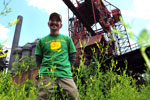
Ronald A. Baraff, director of museums and archives for the Rivers of Steel Heritage Area, which chronicles the history and culture of the industries and mill towns along the rivers, visits the former Carrie Furnace steel mill site in Braddock. Rivers of Steel recently acquired the site from the county to turn into a museum. Sidney Davis | Tribune-Review
The statue of Pittsburgh Pirates legend Honus Wagner might stand outside PNC Park on the North Shore, but fans who desire something more can head six miles down the Parkway West to the Historical Society of Carnegie’s miniature museum to learn about its native son.
In a historic building along West Main Street, a small exhibit on Wagner shares space with yearbooks and photos from area schools, a memorial wall for the town’s military veterans, and a painstakingly crafted scale model of the borough’s buildings along East and West Main Street, all funded without help from the municipality.
“We support ourselves. We figured it was better to be people-funded rather than tax-funded,” said Marcella McGrogan, executive director of the society. “Our town’s streets and parking lots need the help more than we do.”
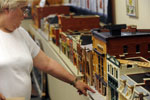
Volunteer Joan Harbin points out a model of the building housing the artifacts and exhibits on display at the Historical Society of Carnegie in the small museum on West Main Street. Keeping up with the maintenance of the building and expansion plans has been a struggle, but officials say local history groups, such as the Carnegie's, help to instill local pride and encourage tourism and redevelopment. James Knox | Tribune-Review
Carnegie is one of many communities in the region with a historical society, which officials say can encourage economic development by drawing tourists, instilling local pride and marketing a community’s historic assets.
“We have a ‘Babushkas and Hardhats’ tour … that looks at the development of the Pittsburgh region, why industry located here, why it isn’t here now and how Pittsburgh has reinvented itself,” said Ron Baraff, director of museums and archives for the Rivers of Steel Heritage Area, which chronicles the history and culture of the industries and mill towns along the rivers.
About 15 acres of the former Carrie Furnace steel mill site in Rankin and Braddock were transferred from the county to Rivers of Steel, and officials hope to turn the former blast furnaces into a museum.
“The idea is to bring people into the region and get them to understand that the past built the present, that that’s the foundation for the future,” he said.
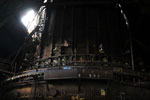
About 15 acres of the former Carrie Furnace steel mill site in Rankin and Braddock were transferred from the county to Rivers of Steel, and officials hope to turn the former blast furnaces into a museum. Sidney L. Davis | Tribune-Review
How and why it helps
The Young Preservationists Society of Pittsburgh released a report last month estimating that preserving and restoring historic properties added at least $475 million to Southwestern Pennsylvania’s economy from 2003 to 2009. Local historical societies can encourage such redevelopment and reinvestment by making people more aware of the history of their communities and homes, said Arthur Ziegler, president of the Pittsburgh History and Landmarks Foundation.
“People tend to believe in the value of that area and are more willing to invest, particularly in historic buildings,” Ziegler said. “It can also develop visitor interest, which can bring income to a town.”
The Sewickley Valley Historical Society is too small to maintain a museum space of its own, but its library allows people to research the history of their families or their homes, said Harton Semple, executive director.
“We’re a small society — only about 400 members — but we have a rich history to draw upon,” Semple said. “We are assailed on all sides by development and general apathy, but we’re beating back that tide.”
The Sewickley Valley society’s “nest egg” was hit hard by the recession, but it has sustained itself with members who made donations above and beyond their yearly membership dues, Semple said. The group published a history of Sewickley last year, and is beginning a push to fund and erect historical markers around the area, he said.
The Historical Society of Mt. Lebanon charges a small fee for its “home history project,” which presents homeowners with a report on the architect who designed their houses, construction plans for them and any other tidbits that members of the historical society can dig up, said Executive Director Margaret Jackson.
Mt. Lebanon’s society is entering its second year of operating a small museum space off Washington Avenue, which hosts rotating exhibits on local subjects such as the nearby Washington School or the Mt. Lebanon Soccer League, Jackson said. More and more residents are donating artifacts and photographs, but that raises the new challenge of how to store and protect them all. Yearly contributions from the municipality’s budget are enough to cover rent on the museum space, she said.
“We’re slowly getting the word out that we’re here, that we’re not just for little old ladies,” Jackson said. “Mt. Lebanon is just celebrating our centennial. … Hopefully, we’ll preserve our community’s past for decades to come.”
The Westmoreland County Historical Society this week moved its library and museum space to a new location on Sand Hill Road, which is more accessible to the many people who use its archives to research their family’s past, said Executive Director Lisa Hays.
“What’s surprising is how far people will travel to study their genealogy. … We had people come from as far away as Australia last week,” Hays said. “Typically, one person will sit and do research while the rest of the family goes out and sees the local sights.”
Hays said local societies help residents understand their communities’ place in the larger events of history, and knowing what roles they played or how they were affected can foster civic pride.
“Everyone thinks nothing ever happened in their backyard, but it did — everything that’s happened on a national level, on a world level, was played out on a local level,” she said. “Once that dawns on people, it creates a real sense of local pride.”
-
Penn Hills Development Group Begins to Bloom
By Tony LaRussa
PITTSBURGH TRIBUNE-REVIEW
Thursday, June 10, 2010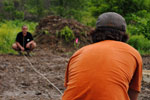
President of the Penn Hills Community Development Corporation Erik Hardy, 58, of Penn Hills works with volunteer Colton Sankey, 17, of Plum High School to form a plumb line as they plot out a community garden. The municipality is allowing the CDC to use a parcel of land along Jefferson Road for a community garden in which residents and groups can rent 4- by 12-foot plots for $20. Samantha Cuddy | Pittsburgh Tribune-Review
Penn Hills’ burgeoning Community Development Corporation took a significant step in its organizing efforts when the state recently designated it as a private, nonprofit organization.
That’s not all. The CDC has a project under way: a community garden.
Since last year, organizers have worked to create an organization to promote the community’s strengths: its location, plentiful and affordable housing, diverse population and parks and other recreation facilities.
Equally important is addressing the poor reputation of the community’s schools, its inability to attract and keep businesses, and the deteriorating quality of life in some neighborhoods caused by crime, poor property maintenance, government-subsidized housing and other factors, officials say.
Working committees include housing, economic development, education, community beautification, public safety and communications. CDC officials are encouraging residents to join the organization and serve on a committee.
“We’ve found that people here have a lot of energy and great ideas for promoting or improving various aspects of the community,” said Erik Hardy, CDC board president. “What we didn’t have was a central place to go to channel that energy and put those ideas into practice. That’s really what led us to form this organization.”
Margie Howard of the Community Technical Assistance Center in Pittsburgh said obtaining nonprofit status from the state is a critical step toward becoming eligible for funding.
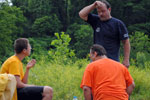
Jim Black, standing, Vice President of the Community Development Corporation of Penn Hills, ponders his next move with fellow workers at the municipality's community garden. David Wolf, right, and his son Gregory Wolf, 13, are helping to construct 4 by 12 foot garden plots which residents and groups can rent. Samantha Cuddy | Pittsburgh Tribune-Review
“You have to have the state designation before applying for federal tax-exempt status,” said Howard, who helped the CDC develop its structure. “There are a lot of state and federal agencies and foundations that require groups to be a tax-exempt, nonprofit organization before they will consider them for grants.”
CDCs operate apart from local government, and money such as federal housing rehabilitation grants are available only to them.
Lack of money has not prevented the CDC from taking on a project its members hope will help spur interest in its activities.
The municipality is allowing the CDC to use a parcel of land along Jefferson Road for a community garden in which residents and groups can rent 4- by 12-foot plots for $20. Municipal officials also have agreed to supply water to the site.
Businesses donated materials, supplies and services for the garden. Penn Hills Lawn and Garden donated soil testing and mushroom manure; Penn Hills Rental provided equipment to clear the site; Hanson Aggregates gave gravel for the access road; and The Home Depot provided lumber, fencing, tools, water barrels and other supplies.
-
Vacant Houses Spur Art Initiative in Wilkinsburg
Thursday, June 10, 2010By Deborah M. Todd, Pittsburgh Post-GazetteWhen Wilkinsburg artist Lazae LaSpina noticed bright neon swirls of abstract art decorating boards used to shutter the North Side’s vacant Garden Theater, she saw an opportunity to spruce up blighted properties in her own neighborhood.
“I could tell people cared about that area,” she said. “In Wilkinsburg, with all of the abandoned properties in that area, I thought that would be a good idea if we did something similar.”
Originally conceived as a small neighborhood project in May 2009, Ms. LaSpina’s idea has grown into a plan that will not only beautify the homes, but could potentially establish the community as a haven for artists. The Whitney Avenue Art Gallery “Houses in Waiting” project kicked off May 28 with a youth orientation event at Hosanna House.
Funded by the Wilkinsburg Weed and Seed, the Pennsylvania Council on the Arts, the Wilkinsburg Municipal Authority and the Wilkinsburg Development Authority, the project’s goal is to recruit community members to paint plywood window covers for 10 to 12 vacant houses on Whitney Avenue’s’s 700 block — transforming the space to what organizers call an “outdoor gallery.”
But if the idea catches on the way Ms. LaSpina and Wilkinsburg officials hope it will, the project will spearhead a push to promote the properties for sale as well as programs available for potential homeowners.
“The theme ‘Houses in Waiting’ intends the board-up art to act as a placeholder while interest is generated for a wide spectrum of home buyers to invest in the neighborhood and take advantage of Wilkinsburg’s ten-year property tax abatement program,” reads the WAAG web site.
The initiative also has potential to bring neighbors in the Hamnett Place community together to collaborate behind a common theme for the artwork. Volunteers are split up into youth and adult groups where professional artists help lead discussion and activities to determine themes.
Artist Ernest Bey, whose work includes elaborate wood carvings created for the Garden Dreams Nursery on Holland Avenue, said he looks forward to speaking to youth about the project.
“I want to challenge students, who are going to be becoming the lead artists on this project. I want their input,” he said. “Because when you involve young people, they come up with something you totally didn’t anticipate.”
Multimedia artist Kate Joranson said she will encourage adult volunteers to observe the environment around the houses to come up with ideas for themes.
“Boarded up buildings and abandoned sites can evoke a lot of emotion,” she said. “I want to try to collect those stories through writing, drawings, maybe collect small objects.”
With the window covers painted and primed, workshops scheduled throughout the month and a grand opening event scheduled for July, organizers are optimistic the initiative will help residents see the community in a new way.
Councilwoman Vanessa McCarthy-Johnson said she hopes the initiative can grow to include more of Ms. LaSpina’s ideas, such as artists in residence and community parties to promote the site. But she said the initial start is more than enough to spark additional improvements in the neighborhood.
“It gives a sense of value instead of devastation to the properties in the neighborhood. People will look at where they live a little different,” she said.
They’ll see its not just an abandoned house, it can be just about anything you want it to be.”
-
Students Pen a Historical Look at Homestead – Book Features Poems, Photos, Essays
Thursday, June 10, 2010By Dana Vogel, Pittsburgh Post-GazetteThanks to the Young Preservationists Association — a nonprofit organization that encourages the participation of young people in historic preservation — the history of Homestead has come alive for a group of Propel Andrew Street High School students.
The association’s Youth Main Street Advisers Program and seven students from Propel Andrew Street held a book signing last Thursday in Homestead to launch their new book, “Take a Walk From the Past to the Future of Eighth Avenue,” published by Red Engine Press.
The book was the result of a year-long project to better understand Homestead’s historic commercial district and to envision a new future.
“Take a Walk From the Past to the Future of Eighth Avenue,” which is divided into three parts representing the past, present and future of Eighth Avenue, features essays, poems and interviews by the students. The book also includes photographs of the neighborhood from the past and present.
Dan Holland, CEO of the youth group, explained the idea for a book came from a desire to do something more enduring than a video. “We wanted something you can see, feel, touch,” he said.
The rest of the story came down to a combination of luck and preparedness, Mr. Holland said. He explained that he ran into his longtime friend Jeremy Resnick, executive director and founder of Propel, at a barber shop and mentioned his idea. With a grant from the Grable Foundation and approval from Propel superintendent Carol Wooten, students from Propel Andrew Street in Munhall turned Mr. Holland’s dream into a reality.
The most significant result of the project seems to be its effect on the students.
Stephanie Nachemja-Bunton, a teacher at Propel Andrew Street and the group’s adviser, said, despite a few initial setbacks, “the seven students who completed the books were dedicated and did a wonderful job.”
She said that in addition to researching Homestead in books and on the Internet, the students took a number of tours of the borough.
Dr. Wooten said not only did the project give the students a stronger sense of community, but it also helped them to meet Pennsylvania academic standards, particularly in communications. She also emphasized that the group aspect of the project will help to prepare the students for the workplace.
The students also agreed that, in the end, the project was about learning.
“The experience was good. I gained knowledge and learned about the community,” said MalikQua Salter, a 17-year-old junior from Rankin, who contributed an essay, interview and photo essay to the book.
MalikQua, whose father grew up in Homestead, wrote in the book, “Eighth Avenue is no longer what it used to be, but many people are coming together to make it what it once was.”
Freshman Janiece Hall, 15, of Penn Hills, said, “I learned about interviewing and communication skills.”
Janiece, who has a poem, photo essay, interview and essay feature in the book, also said that while the project seemed difficult at first, “as it was coming together, it got easier.”
In her poem, she describes earlier excitement on the avenue which is “now as empty as a dried up river bed.”
The result of all the hard work seems well worth it to MalikQua. “The book turned out great. We worked hard and put in a lot of effort, and it’s pretty good,” she said.
Echoing her sentiments, Mr. Holland said: “I’m thrilled with the book. It’s a very compelling product.
“Our hope is that the community will embrace this book as well,” he added.
For a copy of “Take a Walk From the Past to the Future of Eighth Avenue,” call the Young Preservationists Association at 412-363-5964.
-
Elegant Vaudeville-Era Theater in Dormont to be Razed
By Chris Ramirez
PITTSBURGH TRIBUNE-REVIEW
Thursday, June 10, 2010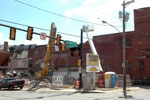
Demolition is taking place at West Liberty and Dormont avenues as the former South Hills Harris Theatre bites the dust. Once the elegant backdrop for countless Vaudeville acts and live-action performances, it will soon be gone, much to the dismay of local historians. It was built in 1927 and opened in 1928. Heidi Murrin | Tribune-Review
Harris moviehouse’s heyday long past, CVS now owns property, hit by vandals, in disrepair.
The final curtain is coming down on the old South Hills Harris Theatre.
Broken windows, stained walls and a partially collapsed roof are all that remain of the once-regal theater on West Liberty Avenue. Soon, the one-time hot spot will be demolished to make way for a pharmacy.
“It’s sad news, as far as I’m concerned,” said Muriel Moreland, president of the Dormont Historical Society, “It’s such a shame because it’s a beautiful building. It’s just one more thing that’s going down, going away.”
Long before there was Dolby Sound, multiplex theaters and six-story IMAX picture screens, there were entertainment houses like the South Hills Harris Theatre, which was the backdrop for countless Vaudeville acts and live-action performances.
It was built in 1927 and opened in 1928. Watching a production there was an experience.
Ushers in tuxedos and white gloves guided theatergoers of the 1930s and 1940s through a main lobby illuminated by the shimmering light of a crystal chandelier. There was no Dolby Sound. For many years, audiences heard just the music of Bob Mitchell, tickling the keys of a Wurlitzer pipe organ.
The site was converted to show motion pictures and short films, including pro-military spots that became popular during World War II.
After years of operation, the theater closed in 2001. Pharmacy giant CVS bought it, along with a corner property and two houses surrounding it, Moreland said. All of them are to be razed, she said.
Despite several fundraising campaigns and efforts to find new owners, the building has been cordoned off from public access, fallen into disrepair and become a magnet for vandalism and animal infestation.
The interior has been gutted. The organ has since been sold to a theater in Ohio. And no one seems to know what happened to the chandelier that greeted theatergoers when they entered.
“One part of it (the theater) is already pretty much rubble,” Moreland said.
Nancy Fenton chronicled the building’s lapse into disrepair over the years, snapping photos of her childhood getaway while walking her dog.
She was a child living in Brookline when she and friends went to see “Psycho” at the theater in the 1960s. “We always made sure we got to sit in the balcony,” said Fenton, 63, of Dormont. “It was like a big opera house.”
Walking there was part of the fun. Coming home later that night was more frightful after sitting through the thriller that “just about did us in,” Fenton said.
“The two houses that were by it had these bushes and trees that used to have branches that were hanging over the sidewalk we’d take to get back home,” she said. “That was spookier than the movie.”
-
Historical Societies Foster Pride and Preservation
By Matthew Santoni
PITTSBURGH TRIBUNE-REVIEW
Thursday, June 10, 2010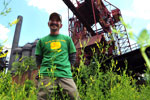
Ronald A. Baraff, director of museums and archives for the Rivers of Steel Heritage Area, which chronicles the history and culture of the industries and mill towns along the rivers, visits the former Carrie Furnace steel mill site in Braddock. Rivers of Steel recently acquired the site from the county to turn into a museum. Sidney Davis | Tribune-Review
The statue of Pittsburgh Pirates legend Honus Wagner might stand outside PNC Park on the North Shore, but fans who desire something more can head six miles down the Parkway West to the Historical Society of Carnegie’s miniature museum to learn about its native son.
In a historic building along West Main Street, a small exhibit on Wagner shares space with yearbooks and photos from area schools, a memorial wall for the town’s military veterans, and a painstakingly crafted scale model of the borough’s buildings along East and West Main Street, all funded without help from the municipality.

Volunteer Joan Harbin points out a model of the building housing the artifacts and exhibits on display at the Historical Society of Carnegie in the small museum on West Main Street. Keeping up with the maintenance of the building and expansion plans has been a struggle, but officials say local history groups, such as the Carnegie's, help to instill local pride and encourage tourism and redevelopment. James Knox | Tribune-Review
“We support ourselves. We figured it was better to be people-funded rather than tax-funded,” said Marcella McGrogan, executive director of the society. “Our town’s streets and parking lots need the help more than we do.”
Carnegie is one of many communities in the region with a historical society, which officials say can encourage economic development by drawing tourists, instilling local pride and marketing a community’s historic assets.
“We have a ‘Babushkas and Hardhats’ tour … that looks at the development of the Pittsburgh region, why industry located here, why it isn’t here now and how Pittsburgh has reinvented itself,” said Ron Baraff, director of museums and archives for the Rivers of Steel Heritage Area, which chronicles the history and culture of the industries and mill towns along the rivers.
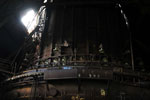
About 15 acres of the former Carrie Furnace steel mill site in Rankin and Braddock were transferred from the county to Rivers of Steel, and officials hope to turn the former blast furnaces into a museum. Sidney L. Davis | Tribune-Review
About 15 acres of the former Carrie Furnace steel mill site in Rankin and Braddock were transferred from the county to Rivers of Steel, and officials hope to turn the former blast furnaces into a museum.
“The idea is to bring people into the region and get them to understand that the past built the present, that that’s the foundation for the future,” he said.
How and why it helps
The Young Preservationists Society of Pittsburgh released a report last month estimating that preserving and restoring historic properties added at least $475 million to Southwestern Pennsylvania’s economy from 2003 to 2009. Local historical societies can encourage such redevelopment and reinvestment by making people more aware of the history of their communities and homes, said Arthur Ziegler, president of the Pittsburgh History and Landmarks Foundation.
“People tend to believe in the value of that area and are more willing to invest, particularly in historic buildings,” Ziegler said. “It can also develop visitor interest, which can bring income to a town.”
The Sewickley Valley Historical Society is too small to maintain a museum space of its own, but its library allows people to research the history of their families or their homes, said Harton Semple, executive director.
“We’re a small society — only about 400 members — but we have a rich history to draw upon,” Semple said. “We are assailed on all sides by development and general apathy, but we’re beating back that tide.”
The Sewickley Valley society’s “nest egg” was hit hard by the recession, but it has sustained itself with members who made donations above and beyond their yearly membership dues, Semple said. The group published a history of Sewickley last year, and is beginning a push to fund and erect historical markers around the area, he said.
The Historical Society of Mt. Lebanon charges a small fee for its “home history project,” which presents homeowners with a report on the architect who designed their houses, construction plans for them and any other tidbits that members of the historical society can dig up, said Executive Director Margaret Jackson.
Mt. Lebanon’s society is entering its second year of operating a small museum space off Washington Avenue, which hosts rotating exhibits on local subjects such as the nearby Washington School or the Mt. Lebanon Soccer League, Jackson said. More and more residents are donating artifacts and photographs, but that raises the new challenge of how to store and protect them all. Yearly contributions from the municipality’s budget are enough to cover rent on the museum space, she said.
“We’re slowly getting the word out that we’re here, that we’re not just for little old ladies,” Jackson said. “Mt. Lebanon is just celebrating our centennial. … Hopefully, we’ll preserve our community’s past for decades to come.”
The Westmoreland County Historical Society this week moved its library and museum space to a new location on Sand Hill Road, which is more accessible to the many people who use its archives to research their family’s past, said Executive Director Lisa Hays.
“What’s surprising is how far people will travel to study their genealogy. … We had people come from as far away as Australia last week,” Hays said. “Typically, one person will sit and do research while the rest of the family goes out and sees the local sights.”
Hays said local societies help residents understand their communities’ place in the larger events of history, and knowing what roles they played or how they were affected can foster civic pride.
“Everyone thinks nothing ever happened in their backyard, but it did — everything that’s happened on a national level, on a world level, was played out on a local level,” she said. “Once that dawns on people, it creates a real sense of local pride.”
-
SEA Consultants Advise Razing Mellon Arena
By Adam Brandolph
PITTSBURGH TRIBUNE-REVIEW
Thursday, June 10, 2010Consultants for the city-county Sports & Exhibition Authority recommended in a draft report sent to the state Bureau of Historic Preservation that Mellon Arena be demolished and the 28-acre Uptown site be developed, SEA officials confirmed Wednesday.
The report, according to Chris Cieslak, a consultant working with Oxford Development and the SEA, “evaluates several alternatives,” but concludes that the Penguins’ plan to demolish the arena and construct a mixed-use development on the site would have the greatest economic benefit to the region. A full copy of the report, which was sent to the preservation bureau last month, was not available.
Representatives from two groups seeking alternatives to demolition walked out of last night’s closed-door meeting with SEA officials and other interested parties because they said the historic preservation process is not being followed.
“Their process is designed to divide and conquer,” said architect Rob Pfaffman. “The democratic process is being badly managed and badly executed.”
The SEA has hosted six other closed-door meetings that included developers and preservationists. A public meeting was held in the lower Hill District last month.
The $321 million Consol Energy Center is set to open across the street from the 49-year-old arena this summer. The main tenant, the Penguins, own the rights to develop the property.
Pittsburgh Mayor Luke Ravenstahl, Allegheny County Executive Dan Onorato and other public officials have said Mellon Arena should be demolished to create room for retail and housing developments. The Sports & Exhibition Authority — whose members are appointed by the mayor and county executive — has the final say on what will happen but has not made public any decision.
The preservation bureau has 30 days to review the draft report, while a consulting firm hired by the two groups seeking alternatives to demolition completes its own study.
“Everybody’s trying to beat the clock now,” said Todd Poole, managing principal of 4Ward Planning, representing Preservation Pittsburgh and ReUse the Igloo. “Obviously, I think from the standpoint of my clients, they would prefer that the process not be rushed.”
Poole hopes to have a “fully fleshed-out analysis that covers all the bases that we’ve discussed to this point” by early July. Poole said the SEA consultant’s plan falls short of a full analysis of what could be done with the arena. He said adding more retail space to an area with vacancies is a poor idea.
Gary J. English, a Penn Hills resident who filed for the Igloo’s historic preservation and has attended the SEA’s closed-door meetings, wants Allegheny County voters to decide the fate of the arena with a ballot initiative.
“I think the whole process is a farce,” English said. “They had one public meeting in the Hill District, but (the arena’s) owned by the residents of the entire county.”
-
HRC Gives Conditional Nod to Apartments in Old Uptown School
Thursday, June 03, 2010By Diana Nelson Jones, Pittsburgh Post-GazetteThe Historic Review Commission Wednesday conditionally approved the plans of an investment group to renovate the former Fifth Avenue High School, Uptown, into 65 rental lofts.
Casey Steiner and Jonathan Hill, on behalf of the new owner, an investment partnership called LMS 5th LP, said they propose to restore the exterior to national historic standards and build a new parking lot of two levels, the higher about 3.5 feet above sidewalk level on the Fifth Avenue side to be accessible to the handicapped.
Provided financing “falls into place,” Mr. Steiner said, work on the 5th Avenue School Lofts could be under way by fall. “We’re pretty confident.”
The market, he said, is graduate students, empty nesters, people who work Downtown, in Oakland, at Mercy Hospital and Duquesne University.
The commission’s conditions are that the development partners provide more detail of the composition of concrete facing on the parking deck, screening of the deck and railings.
The investors provided historic planner Katherine Molnar proof of approval from the U.S. Department of the Interior, which is charged with upholding historic standards. The former school is a nationally designated historic structure, and the investment will receive federal historic tax credits.
Mr. Steiner, president of Impakt Development, said the partnership paid $640,000 last year for the building from Excel Kitchens, which operated out of a small part of the school, which was built in 1894, closed in 1976 and was otherwise empty that long.
In other matters, the commission approved Eat’n Park Hospitality Group’s plan to build a restaurant in Schenley Plaza, nearest where Forbes Avenue and Pennant Place meet.
The building will have two living walls, a green roof on which herbs and vegetables will be grown for the restaurant and a rain barrel will collect water. It will be one-story, built of limestone, red cedar, a metal canopy, glass and stacked stone. Facing the park, it will have a “transitional patio” — covered but without walls, said Mark Broadhurst of the Eat’n Park Hospitality Group. It has not been named but will not be called Eat’n Park, he said.
The project is being financed by the hospitality group, said Mr. Broadhurst. The group will lease from the Pittsburgh Parks Conservancy.

